The Future is Socialism
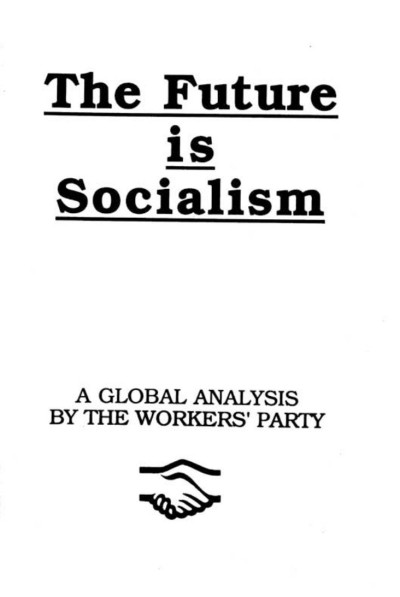
| Date: | 1993 |
|---|---|
| Organisation: | The Workers' Party |
| View: | View Document |
| Discuss: | Comments on this document |
| Subjects: |
Please note: The Irish Left Archive is provided as a non-commercial historical resource, open to all, and has reproduced this document as an accessible digital reference. Copyright remains with its original authors. If used on other sites, we would appreciate a link back and reference to The Irish Left Archive, in addition to the original creators. For re-publication, commercial, or other uses, please contact the original owners. If documents provided to The Irish Left Archive have been created for or added to other online archives, please inform us so sources can be credited.
Commentary From The Cedar Lounge Revolution
22nd October 2007
Long time contributor to our comments Garibaldy has written an introduction to a Workers' Party document from 1993. This was after the split which resulted in the formation of New Agenda, and later Democratic Left and provides a genuine insight into the thinking of the party during a profoundly difficult period. To me it is interesting how critical it is of unexpected figures. Conor Cruise O'Brien get's a lash and overall the tone is quite confident, albeit realistic (incidentally, on another tack, the other day I asked did anyone have an SWP or SP/Militant material, or indeed SF material. The point was made that much of this is already on the web, which is true, but the purpose of the Archive is not merely to collate it in a single easily accessible source but also to get some sense of those who are or were in the Irish left organisations to which it relates in order to build up some sense of the 'social' history. We have no party line, we don't censor and we welcome all contributions).
This document was produced by Des O’Hagan, one of the leading theoreticians of The Workers’ Party, for a Special Delegate Conference in November 1993. If Patterns of Betrayal was designed to explain how the 1992 split had come about, The Future is Socialism reasserted The Workers’ Party’s core beliefs in the wake of the changed international and national situation. The very title is a riposte to the end of history. Rereading it in 2007, what is most striking is how accurate its predictions about those retreating from socialism globally were to be, and how different the challenges facing Irish society, north and south, and the Irish left are now.
It is worth briefly remembering the circumstances of November 1993: in the north, despite much recent discussion of peace and even some temporary ceasefires, the Shankill Bombings and the Trick or Treat Massacre at the Rising Sun bar in October suggested that an explosion of sectarian violence unmatched the 1970s was imminent, and the political process seemed deadlocked. Mass unemployment remained a major problem in both states, as did emigration. Ireland was a much more Catholic country – divorce remained illegal, and the moral authority of the church, though damaged, remained extremely powerful. That Ireland has to a large extent disappeared, but reading the pamphlet is a reminder of how suddenly and unexpectedly many of the changes occurred.
Just to mention briefly some of the things that stood out for me. From the very start, The Future is Socialism makes clear the centrality of international forces to its analysis, and to the politics of The Workers’ Party. The 1992 split, and the arguments offered by the DL faction, are presented as local variations of wider developments. Ditto the developments in the leadership of the British Labour Party from which New Labour would emerge. It rejects the rise of managerialism, and insists on the centrality of the question of ownership. The central role of the State in economic development is affirmed. The pamphlet is grounded in a materialist analysis, but (in a somewhat Gramscian way) it insists on the importance of optimism and of ideological struggle. The belief in the need for a disciplined and coherent campaigning party is made clear in the condemnation of those sought to “reduce The Workers’ Party to just another political party”. The revolutionary impact of democratic reforms is an underlying assumption worth thinking about.
The Future is Socialism reminds us of how much has changed but also how much has stayed the same. The economic and social conditions analysed have in some respects changed a great deal. Immigration and house prices, not emigration and unemployment, now dominate public debate. The social assumptions of the Catholic church no longer hold much sway. Depressingly, sectarian politics retain their power and a strong and effective Bill of Rights remains absent. Education remains denominational, north and south. Ireland lacks a democratic culture. Managerialism is the dominant position in European and American politics. The continued privatisation of key state assets and the failure of the anti-capitalist movement of a decade ago to effect much of anything demonstrate the extent to which ownership and organisation addressed in the pamphlet remain key questions for socialists of every variety.
More from The Workers' Party
The Workers' Party in the archive
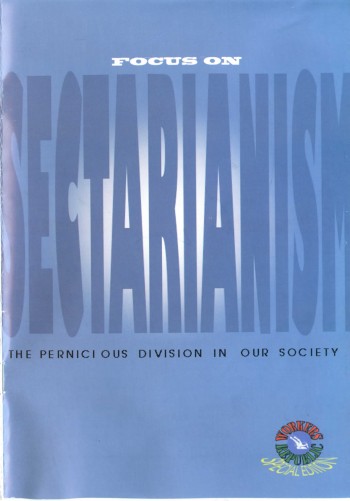
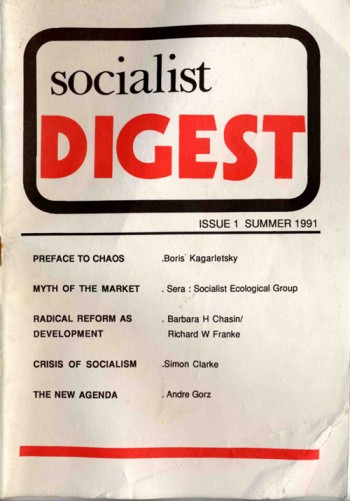
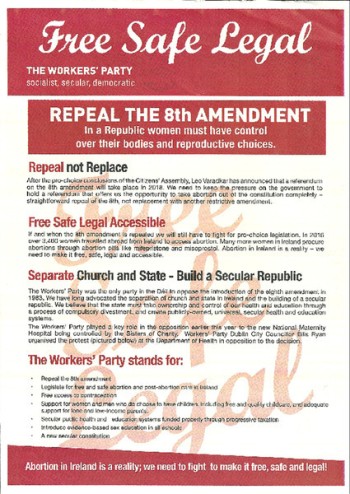
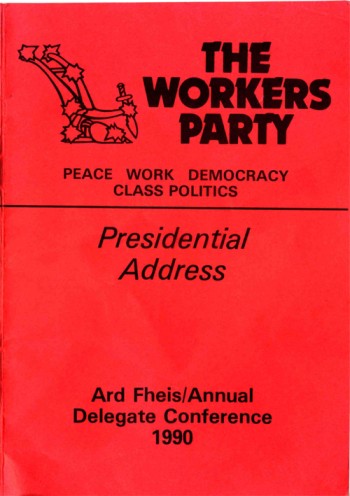
Comments
No Comments yet.
Add a Comment
Comments can be formatted in Markdown format . Use the toolbar to apply the correct syntax to your comment. The basic formats are:
**Bold text**
Bold text
_Italic text_
Italic text
[A link](http://www.example.com)
A link
You can join this discussion on The Cedar Lounge Revolution
By: Garibaldy Tue, 23 Oct 2007 12:43:28
Ed,
As far as I know, they were criticised at the time.
The ability to form free trade unions is certainly an important, and vital one. However, so was the ability to defeat imperialism in former colonies like Cuba and Vietnam, which would have been impossible without the USSR. Hence my comments about the balance sheet. My point about the VCR was that the economy should have been turned towards the production of consumer goods, thus meeting the needs and demands of the citizens. A more responsive economic policy was certainly one of the positive things Gorbachev was trying, but in many sense by then it was too late.
Reply on the CLR
By: Ed Hayes Tue, 23 Oct 2007 13:20:06
I suppose it also does come back to a conception of socialism as well though. Is the emancipation of the working class ‘the act of the working class’ or can it be imposed/brought about by foreign armies, guerillia fighters, benevolent dictators? Is it all state control of society? There were no revolutions in Poland, East Germany, Hungary etc, ‘socialism’ was imposed there on the foot of Russian occupation and no matter how thankful many millions were to get the Nazis out, for a variety of reasons lots weren’t too happy to see the Russians staying. The probelm with a balance sheet is that we are two people in western society, with access to PCs on our lunch breaks, balancing off trade rights for workers in Russia with military and financial support for the Viet Cong. Oleg B. Steelworkski in Vladivostok would more than likely see things a bit differently. Your back in ‘can’t make omelletes’ territory again…
Reply on the CLR
By: ejh Tue, 23 Oct 2007 13:38:46
I wonder whether you could suck the egg out of the shell using a syringe.
Reply on the CLR
By: Garibaldy Tue, 23 Oct 2007 13:53:18
Ed,
I understand the point you’re making. Socialism should be something that comes from the working class of a country rather than being imposed from the outside. But the circumstances in which the Soviets found themselves after WWII in central and eastern Europe were hardly normal ones. And let’s not forget that in places like Czechoslovakia there a communist majority among the proletariat already by 1947. We also should remember just how anti-semetic and right-wing many of the political groups and large segments of the population in these places were. Especially Poland, the Baltic States, and Hungary. The USSR was faced with an extremely difficult strategic problem worsened by the nuclear monopoly. Withdraw, and risk nationalistic or fascistic governments hostile to the USSR emerging, and end up facing the risk of another invasion from US troops on your doorstep, or attempt to build alternative regimes with sympathetic local elements. I doubt we’ll ever see such circumstances again, so in many respects the whole thing is a moot point now.
This goes to the omlettes question. Nobody in the 1920s or 1930s in Russia would have been tolerant of their political opponents, and had the Bolsheviks lost the civil war, or had the kulaks been able to push a new government on the place in the 1920s or 1930s, then what would have taken place would probably have been much bloodier than what did occur. We must bear all this in mind. We today have a much lower level of acceptable violence than people nearly 100 years ago not long after WWI or 50 years ago not long after WWII.
The balance sheet is messy I agree. But we live in a messy world. We must never forget that what drives how bloody a revolution is is the extent of resistance which it meets. If anbody is interested in this question, and ever gets the chance, they should read ‘The Furies’ by Arno Mayer. It’s a big work of comparative history on violence in the Russian and French Revolutions, arguing that the bloody turns they took were due to the amount of resistance they met. Ditto the attitude to the churches, which were so entwined with the old regimes they became the engines of counter-revolution.
It seems to me that these types of questions are the ones being wrestled with in ‘The Future is Socialism’. Terrible mistakes have been made in pursuit of the socialist project, but the project is not invalidated. In addition, the need for a clear-eyed, objective and calculating look at what is needed to produce socialism is greater now than it was in 1993, but the methodology of analysis in the pamphlet seems to me to be of potentially great use.
Reply on the CLR
By: Justin Tue, 23 Oct 2007 13:57:54
I know my presence on this site has largely involved transmitting other people’s ideas but other people have put things much better and more expertly than I could.
So, I’d like to add another point of reference to this debate. International Publishers in New York seems to be connected with the CPUSA. In 2004 they published Socialism Betrayed by Roger Keeran and Thomas Kenny about the collapse of the USSR. In some interesting ways it overlaps with the WP document, Patterns Of Betrayal [http://workerspartyireland.net/id7.html], which has been discussed on here before. Although, of course, the tragedy of the USSR was writ larger, some of the same thinking that lay behind the demise of the USSR was articulated by New Agenda-ers and Eoghan Harris.
Interestingly, the book received a critical review in the CPUSA’s monthly magazine Political Affairs [http://www.politicalaffairs.net/article/articleview/234/1/35/]. I don’t know much about the CPUSA but I imagine that it has a mixture of Eurocommunist and “Tankie” thinkers in its ranks.
Anyway, the main point of Socialism Betrayed is that the USSR didn’t collapse so much as it was pushed. Keerran and Kenny argue that since its beginnings the USSR command was dominiated by two main trends of thought. One , exemplified in the first instance by Bukharin (and later by Kruschev and eventually by Gorbachev), was essentially social democratic and largely heedless of the importance of the nationalities question within the USSR. The other more left wing trend, exemplified by Lenin and Stalin (and later by Adropov and Gorbachev for a short period) took the nationalities question more seriously but ultimately failed because of a bureaucratic counter-revoultion which, whatever its initial reformist motivation, moved quickly towards dismantling the socialist constitution.
They also argue that a massive black economy developed alongside the state economy and produced a strong middle class whose interests, they believed, coincided with the collapse of the system. Ordinary wokers meanwhile were filled with dreams consumer abundance while the system under which they lived had manifestly failed to address the people’s desire for quality goods -hence the black economy.
So, according to these authors the USSR collpased because “of a triumph of a certain tendency within the revolution itself. It was a tendency rooted at first in the peasant nature of the country and later in a second economy, a sector that flourished because of consumer demands unsatisfied by the first economy and because of the failure of authorities to appreciate the danger it represented and to enforce the law against it.”
According to Political Affairs, Keenan and Kearney, “end where one must actually begin. Why couldn’t the first economy satisfy the need for consumer goods, why did the bureaucracy foment counter-revolution?” It’s a good question and one not really addressed by this book. But the kind of analysis presented in Socialism Betrayed, as opposed to a list of sins and transgressions, helps me to undestand the past trajectory of the socialist project in Russia.
S
ocialism Betrayed: Behind the Collapse of the Soviet Union.
By Roger Keeran and Thomas Kenny
New York, International Publishers, 2004.
Reply on the CLR
By: The Left Archive: “The Future is Socialism” from the Workers’ Party post-split 1993 Mon, 29 Oct 2007 11:39:54
[…] guestposter Blogged about a good topic today on cedarlounge.wordpress.comRead this excerpt: […]
Reply on the CLR
By: Budapestkick Thu, 24 Jun 2010 16:43:27
In reply to Garibaldy.
‘ not even Trotsky thought the USSR was beyond repair in the 1930s’
Wouldn’t agree entirely with that. He was calling for a political revolution which is a demand that went a fair bit beyond repair. After the rise of Hitler he certainly had concluded that the Comintern was irredeemable
Reply on the CLR